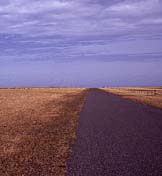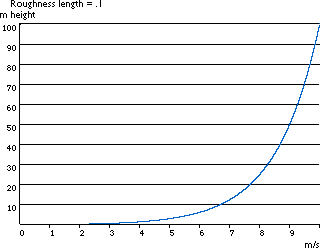Roughness and Wind Shear
![]()
High above ground level, at a height of about 1 kilometre, the wind is hardly influenced by the surface of the earth at all. In the lower layers of the atmosphere, however, wind speeds are affected by the friction against the surface of the earth. In the wind industry one distinguishes between the roughness of the terrain, the influence from obstacles, and the influence from the terrain contours, which is also called the orography of the area. We shall be dealing with orography, when we investigate so called speed up effects, i.e. tunnel effects and hill effects, later.
Roughness
In general, the more pronounced the roughness of the earth's
surface, the more the wind will be slowed down.
![]() Forests and large cities obviously slow the
wind down considerably, while concrete runways in airports will
only slow the wind down a little. Water surfaces are even smoother
than concrete runways, and will have even less influence on the
wind, while long grass and shrubs and bushes will slow the wind
down considerably.
Forests and large cities obviously slow the
wind down considerably, while concrete runways in airports will
only slow the wind down a little. Water surfaces are even smoother
than concrete runways, and will have even less influence on the
wind, while long grass and shrubs and bushes will slow the wind
down considerably.
Roughness Classes and Roughness Lengths

Photograph © 1998
Soren Krohn

This graph was plotted with the wind
speed calculator on the next page. It shows you how wind
speeds vary in roughness class 2 (agricultural land with some
houses and sheltering hedgerows with some 500 m intervals), if
we assume that the wind is blowing at 10 m/s at a height of 100
metres.
![]() The fact that the wind profile is twisted
towards a lower speed as we move closer to ground level, is usually
called wind shear. Wind shear may also be important when
designing wind turbines. If you consider a wind turbine with
a hub height of 40 metres and a rotor diameter of 40 metres,
you will notice that the wind is blowing at 9.3 m/s when the
tip of the blade is in its uppermost position, and only 7.7 m/s
when the tip is in the bottom position. This means that the forces
acting on the rotor blade when it is in its top position are
far larger than when it is in its bottom position.
The fact that the wind profile is twisted
towards a lower speed as we move closer to ground level, is usually
called wind shear. Wind shear may also be important when
designing wind turbines. If you consider a wind turbine with
a hub height of 40 metres and a rotor diameter of 40 metres,
you will notice that the wind is blowing at 9.3 m/s when the
tip of the blade is in its uppermost position, and only 7.7 m/s
when the tip is in the bottom position. This means that the forces
acting on the rotor blade when it is in its top position are
far larger than when it is in its bottom position.
© Copyright 1999 Soren Krohn. All rights reserved.
Updated 6 August 2000
http://www.windpower.org/tour/wres/shear.htm
